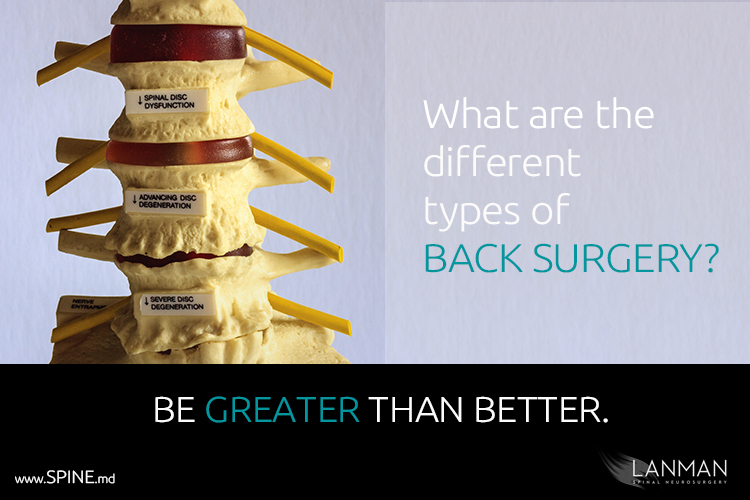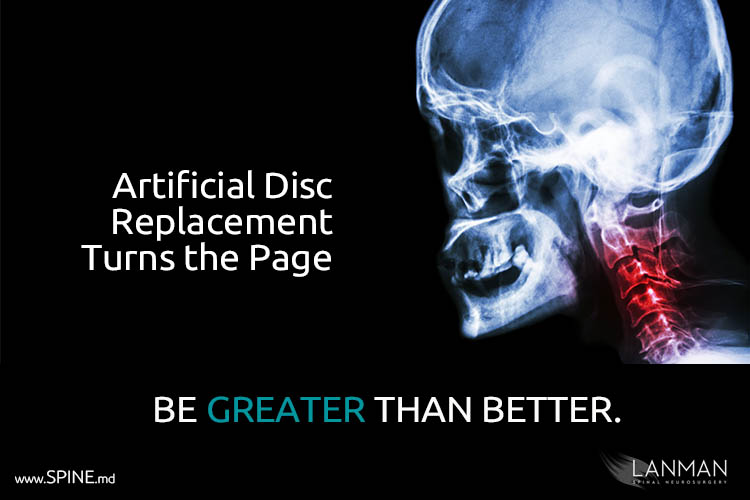Laminectomy, discectomy, spinal fusion, and artificial disc replacement are the four principal types of back surgery to treat conditions such as degenerative disc disease, spinal stenosis, spondylolisthesis, and other disorders of the spine.
Laminectomy
Laminectomy is often recommended for patients suffering from spinal stenosis, or a progressive narrowing of the nerve channels (the foramen) within the vertebral bone. The “narrowing” is caused by abnormal bone growth that eventually compresses the spinal cord and
nerves that are inside the channels. The condition can lead to persistent radiating pain, and nerve weakness. The procedure involves removal of the lamina, a portion of the posterior facet of the vertebrae.
When the lamina is removed, the foramen is partially exposed, and the cause of the nerve compression is revealed. The surgeon may “clean out” the foramen so that the spinal cord and the nerve roots have more room (nerve decompression). Laminectomies are performed on any portion of the spine (cervical, thoracic, lumbar). The procedure may take 1 to 2.5 hours depending on the amount number of vertebral levels that require treatment.
Discectomy
Discectomy is performed when it is necessary to remove a small portion of a herniated spinal disc (and sometimes bone) to relieve the nerve compression causing pain and numbness in the arms or legs. Since only a small portion of disc material (or bone) is removed to reduce the compression, the procedure can be performed on an outpatient basis where equipment is available (microdiscectomy and endoscopic discectomy). The procedure begins with a small incision (about 1″) in the skin. The surgical ‘bundle’ (e.g., scope, cutters, tubes) are inserted through the incision and around the muscles of the bony the lamina. The surgeon then cuts through the ligament that overlays the nerve roots (ligamentum flavum) and uses either an operating glass (loupes) or an operating microscope to see the nerve root.
Sometimes a small part of the inside facet joint of the vertebrae might need to be shaved 1 – 2 mm so that the surgeon has clear access to the nerve root and the portion of the disc that is placing pressure on the nerve. The nerve root is pushed gently aside, and the surgeon cuts away disc material that is impacting the nerve root. Discectomies (or micro-endoscopic discectomies) may be performed on any portion of the spine (cervical, thoracic, lumbar). The procedure may take 40 minutes up to 2 hours depending on the amount number of vertebral levels that require treatment.
Spinal Fusion
Spinal fusion is major surgery that joins together two or more vertebrae to control the effects of degenerative disc disease and other disorders of the spine. Among the oldest medical procedures still in use today, it was first developed around the turn of the 20th Century to help tuberculosis patients cope with the curvature of the spine (scoliosis) that often occurred after suffering life-threatening infection. The procedure was introduced in the early 1940s to help patients cope with other disorders of the spine.
There are several types of spinal fusion – cervical and lumbar fusions, interbody fusions, transforaminal interbody fusion. These procedures can be applied to any region of the spine (cervical, thoracic, lumbar).
The main goal of spinal fusion is to prevent motion in the treatment area of the spine. Highly specialized steel screws, rods, and plates are used to stabilize two or more vertebral segments (levels). The area is prepared for bone graft material often taken from the patient’s hip. Graft material can also come from a bone donor. The “fusion” occurs when the grafting material grows into the treatment area to form a single solid bony structure.
The addition of fiber-optic surgical tools (endoscopic) has reduced the invasiveness of the procedure. These specialized tools reduce damage to surrounding tissue during surgery and encourage faster patient recovery. However, even with the introduction of advanced medical equipment, the surgery may take up to 8 hours and require 6 to 12 months of time-off recovery.
Artificial Disc Replacement
Artificial disc replacement surgery (or total disc replacement) replaces spinal discs that have been herniated or ruptured. Currently, the procedure is approved by the FDA for the cervical (neck) and lumbar (lower back) regions of the spine.
Artificial disc replacement surgery was first performed in the early 1980s in Europe and was introduced into the United States in 2000. Since then, both the procedure and the artificial discs themselves have undergone intense study in numerous favorable clinical trials. After post-operative recovery, patients often report full restoration of their range of motion and flexibility.
To start the surgical procedure, the surgeon will perform a discectomy to remove the damaged or herniated disc between two vertebrae. After some preparation of the area, the surgeon will insert the artificial disc. The end plates of the artificial disc are designed to encourage natural fixation to the vertebrae.
There are several artificial discs that have been approved by the FDA. Prestige LP and Prodisc-C are the most often used; Bryan, Secure-C, and Mobi-C are also frequently used. All mentioned discs have several things in common. First is the material; usually a metal structure with a semi-flexible biopolymer that mimics the function of the original natural disc.
Artificial disc replacement surgery usually takes up to 1 hour per disc. But the recovery period is often no more than 6 weeks.
Post-Operative Experience
The specifics of the patient post-operative experience depend upon the procedure performed and the age and physical condition of the patient.
Many patients leave the recovery room and go home with less pain than they had before their back surgery. Spinal fusion produces the longest recovery period, up to 6 months to a year before the patient can return to most normal daily activities. Total disc replacement (artificial disc surgery) has emerged as the new standard to aggressively treat back and neck pain, partially because of the comparatively short recovery period of 3 to 6 weeks.
As with all back surgery, careful follow-up and rehabilitation is essential. Inform your surgeon if there are sudden changes or if persistent pain or numbness return.
###







